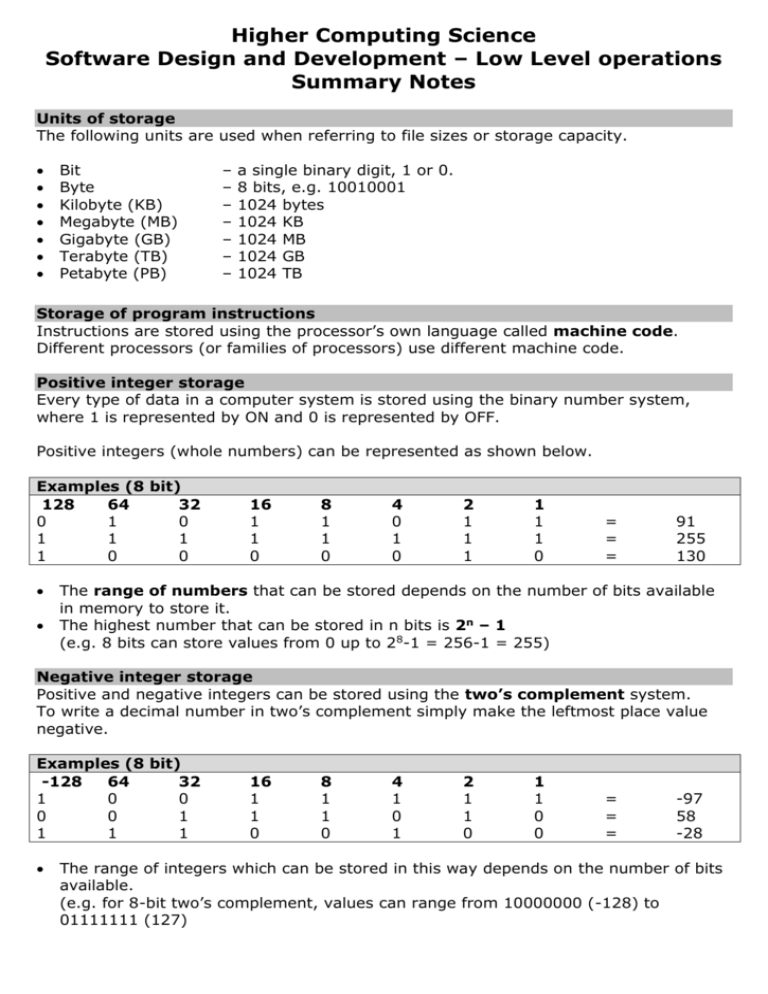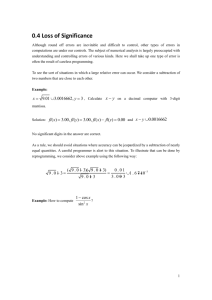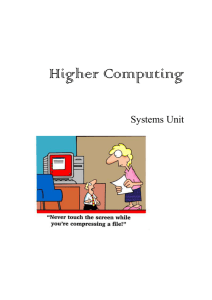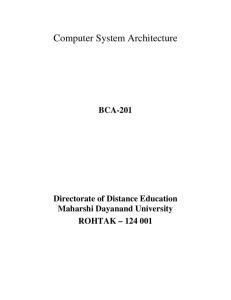Summary notes – SDD – Low Level – Higher
advertisement

Higher Computing Science Software Design and Development – Low Level operations Summary Notes Units of storage The following units are used when referring to file sizes or storage capacity. Bit Byte Kilobyte (KB) Megabyte (MB) Gigabyte (GB) Terabyte (TB) Petabyte (PB) – – – – – – – a single binary digit, 1 or 0. 8 bits, e.g. 10010001 1024 bytes 1024 KB 1024 MB 1024 GB 1024 TB Storage of program instructions Instructions are stored using the processor’s own language called machine code. Different processors (or families of processors) use different machine code. Positive integer storage Every type of data in a computer system is stored using the binary number system, where 1 is represented by ON and 0 is represented by OFF. Positive integers (whole numbers) can be represented as shown below. Examples (8 bit) 128 64 32 0 1 0 1 1 1 1 0 0 16 1 1 0 8 1 1 0 4 0 1 0 2 1 1 1 1 1 1 0 = = = 91 255 130 The range of numbers that can be stored depends on the number of bits available in memory to store it. The highest number that can be stored in n bits is 2n – 1 (e.g. 8 bits can store values from 0 up to 28-1 = 256-1 = 255) Negative integer storage Positive and negative integers can be stored using the two’s complement system. To write a decimal number in two’s complement simply make the leftmost place value negative. Examples (8 bit) -128 64 32 1 0 0 0 0 1 1 1 1 16 1 1 0 8 1 1 0 4 1 0 1 2 1 1 0 1 1 0 0 = = = -97 58 -28 The range of integers which can be stored in this way depends on the number of bits available. (e.g. for 8-bit two’s complement, values can range from 10000000 (-128) to 01111111 (127) Real number storage Real numbers (numbers with a fractional part) are stored using the floating point system, which stores the mantissa and the exponent. Example In the number 0.10100001 x 21011, the mantissa is 0.10100001 and the exponent is 1011. Floating point representation is a very useful way of storing very large or very small numbers, although some accuracy may be lost depending on bits available for storage. Increasing the number of bits available for the mantissa means the precision of the numbers improves, since more digits can be stored. Increasing the number of bits available for the exponent means the range of numbers that can be stored increases. Character storage Text is converted into binary using a code, where each character is represented by a binary number. ASCII code converts each character into an 8 bit binary number. This allows for 256 different characters (28=256). Unicode converts each character into a 16 bit binary number. This allows for 65536 different characters (216=65536). This allows representation for all possible characters from all the known alphabets in the world. Graphic storage – bitmapped A bitmap image is stored as a sequence of binary numbers, each number representing the colour of a pixel. The number of bits used to store the colour of each pixel is known as the bit depth. If the bit depth of the file is less than 24 then the actual RGB code may be stored in a separate colour palette, in order to reduce file size. RGB colour codes are created by using 8 bits for each of the three primary colours (red, green and blue) then combining them to produce a 24 bit colour code. True colour bitmapping uses 24 bits per pixel (16 777 216 colours). Graphics storage – vector Vector graphics store the attributes of every object in the image (e.g. circle: centre x, centre y, radius, fill colour, line thickness, etc). 2D vector graphics can be created using the SVG language while 3D vectors can be created using VRML. Bitmapped Manipulate at pixel level. Typically a larger file size. File size is affected by resolution of image. Becomes pixellated (blocky) when enlarged. Ideal for photos and realistic images. Vector Manipulate at object level. Typically a small file size, although it will increase as more objects are added to the image. Can be enlarged without affecting quality (it is resolution independent). Ideal for simple logos on websites, etc. Video storage Video is stored as a sequence of bitmap images. The frame rate of the video affects the quality of playback and the file size. A typical frame rate is 25fps (frames per second). Other factors affecting quality are the resolution and the bit depth. Audio storage Sound is stored digitally by sampling the original analogue sound. Sampling means taking measurements of the signal. This process of digitising sound means that quality will be lost. Sample frequency is the number of times each second that the sound is sampled. Sample frequency is measured in Hertz (Hz). A frequency of 1Hz means one sample per second. The greater the sampling frequency, the better quality the sound but the larger the file size. Sample depth refers to the number of bits available to record the sound level at each sample. The greater the sampling depth (i.e. the more bits available), the better quality the sound but the larger the file size. CD quality sound has a sample frequency of 44.1 KHz and a sample depth of 16 bits and is stereo. Computer architecture - Processor The CPU (Central Processing Unit) is the main processor in a computer. It has 3 main components: Control Unit – manages the execution of program instructions and fetching from memory. ALU (Arithmetic and Logic Unit) – performs arithmetical operations (add, subtract, multiply, divide) and logical decisions (AND, OR, NOT). Registers – Temporary storage locations inside the processor, such as the Instruction Register, the Accumulator and the Program Counter. Computer architecture - Memory Memory is used to store programs while they are running. It is organised into millions of individual storage locations, each with a unique binary address. RAM (Random Access Memory) – can be written to, stores program which are in use, loses its contents when power is switched off. SRAM (Static RAM) is a type of RAM with fast access speeds, but expensive per MB, good for registers and cache memory. DRAM (Dynamic RAM) is a type of RAM with slower access speeds than SRAM but cheaper per MB, suitable for main memory. ROM (Read Only Memory) – can’t be written to, retains contents even when power is switched off. Used to store the bootstrap loader, the program which loads up the OS when the computer is turned on. Cache – an area of fast access memory, physically close to the processor used to store frequently used instructions and therefore improve system performance. Multi-level cache may be used – L1 (fastest but smallest) is checked first, then L2, then L3, etc. Computer architecture - Buses Buses are sets of wires which connect the processor and memory. Data bus – caries binary data to and from memory. Address bus – carries the memory location which data is to be written to or read from. Control bus – comprises several discrete lines, including: Read line – used to signal a memory read operation. Write line – used to signal a memory write operation. Clock line – carries electronic pulses to CPU to keep components synchronised. Reset line – carries a signal which returns processor to its original state. Interrupt line – carries a signal to processor when a peripheral requires attention. Computer architecture – Fetch-execute cycle The way the CPU repeatedly fetches an instruction from memory, decodes it, and then executes it, is called the fetch-execute cycle. Memory Read operation 1. CPU sets up the address bus with the required memory address by placing a value in the Memory Address Register. 2. The Control Unit activates the read line. 3. The contents of the storage location with that address are released on to the data bus and copied into the Memory Data Register. 4. The data is decoded and executed. Memory Write operation 1. CPU sets up the address bus with the required memory address by placing a value in the Memory Address Register. 2. CPU sets up data bus with value to be written to memory, by placing the value in the Memory Data Register. 3. The Control Unit activates the write line. 4. The contents of the Memory Data Register are transferred to the appropriate storage location. Computer architecture – Addressable memory Addressable memory is the maximum amount of memory which a particular computer can actually use. Adding any more memory than this is pointless as the computer will be unable to use it. ● Address bus width determines how much memory can be addressed. No matter how much RAM is available, the address bus determines how much of it can actually be used. For example, there may be 16777216 storage locations in RAM, but a 16 bit address bus can only access 216 = 65536 of them. ● The width of the data bus gives us the word size (aka word length) – the number of bits that can actually be carried to and from each storage location. For example, a 16 bit data bus means the computer has a word length of 16 bits. In combination, these allow us to work out the amount of addressable memory. Example (addressable memory) A computer has a 32 bit data bus and a 24 bit address bus - calculate the addressable memory. The word size is 32 bits. The number of locations that can be addressed is 224 = 16777216. The amount of addressable memory is therefore: 16777216 locations x 32 bits = 536870912 bits = 67108864 bytes = 65536 Kb = 64 Mb of addressable memory. Computer architecture - Interfaces An interface is a hardware device which compensates for differences in the way peripherals (devices connected to the computer) and the CPU operate, and allows them to communicate with one another. Some specific functions an interface carries out include: Protocol conversion - A protocol is a set of rules (such as data format, voltage, etc) which determines how data is transmitted. Different devices may have different protocols, so an interface is required for data exchange. Data format conversion - The format of data may need to be altered between serial and parallel or analogue and digital. Serial transmission involves sending each bit, one after the other, along a single line – this is slow, but efficient over longer distances (e.g. a network) and adequate for simple operations (e.g. a mouse). Parallel transmission involves sending each bit along separate lines, all at the same time – this is fast, but only suitable for short distances (generally between the CPU and peripherals. Analogue to digital - Some devices deal with a wide range of possible values (analogue) and require conversion to be dealt with by a digital device. Voltage conversion - Since devices operate and send signals at different voltages, an interface must compensate. Buffering - When devices are working at different speeds, a buffer can be used to compensate. Status signals - Status signals from a device indicate when it is ready to send or receive data. Virtual machines A virtual machine is an emulation of a real computer system. One physical computer is used to perform like other computers, so no need to purchase different hardware. Less space required for several computers. Fewer computers being powered so reduced energy consumption. A virtual machine does not run as efficiently as a real machine, since it cannot directly access hardware components. Running virtual machines can be processor and RAM intensive, resulting in poor performance. Emulators Emulation software imitates an item of computing hardware, such as a mobile phone or an obsolete computer. Game console emulators are a popular way of playing retro video games Disc imaging software emulates a physical storage device such as magnetic tape.









